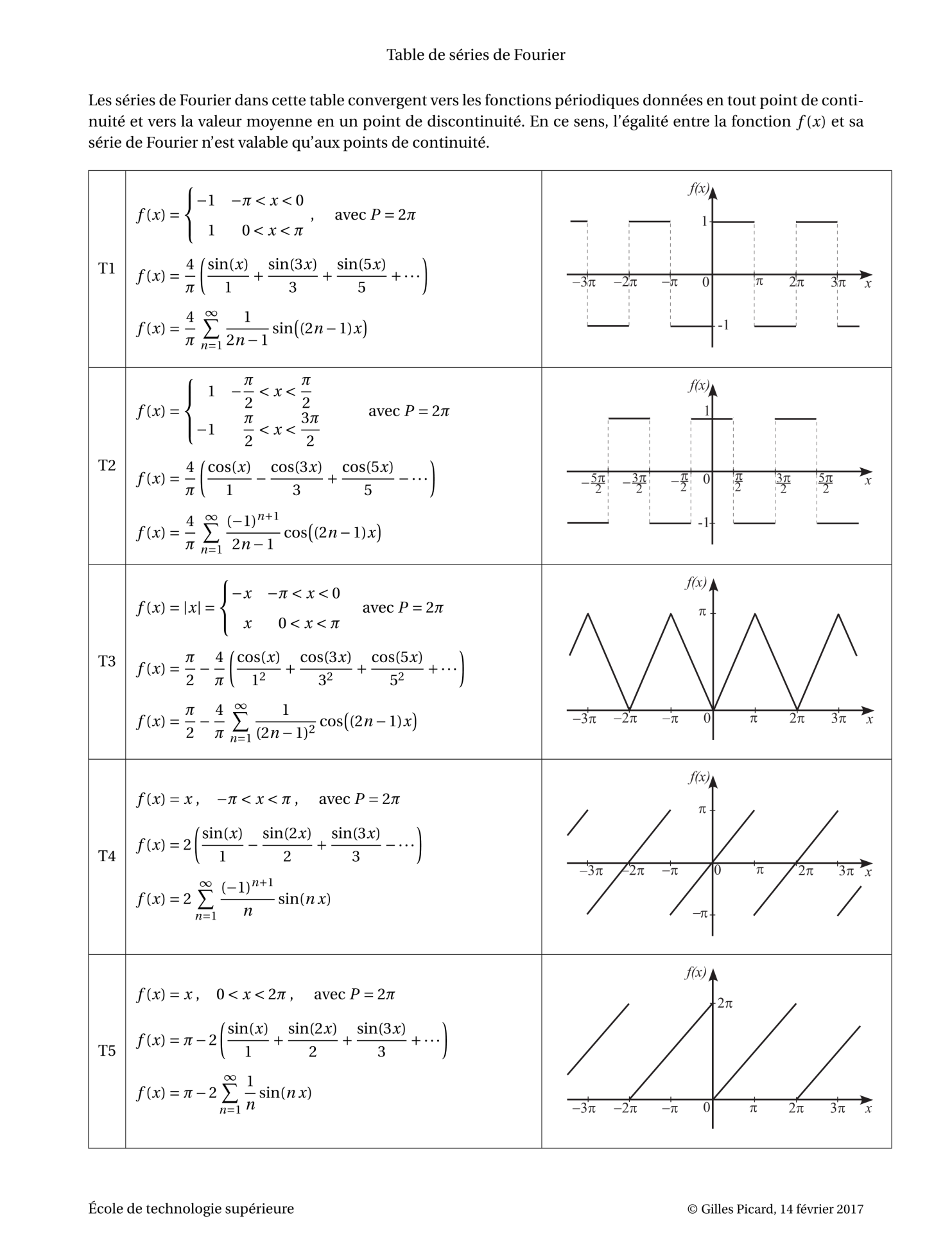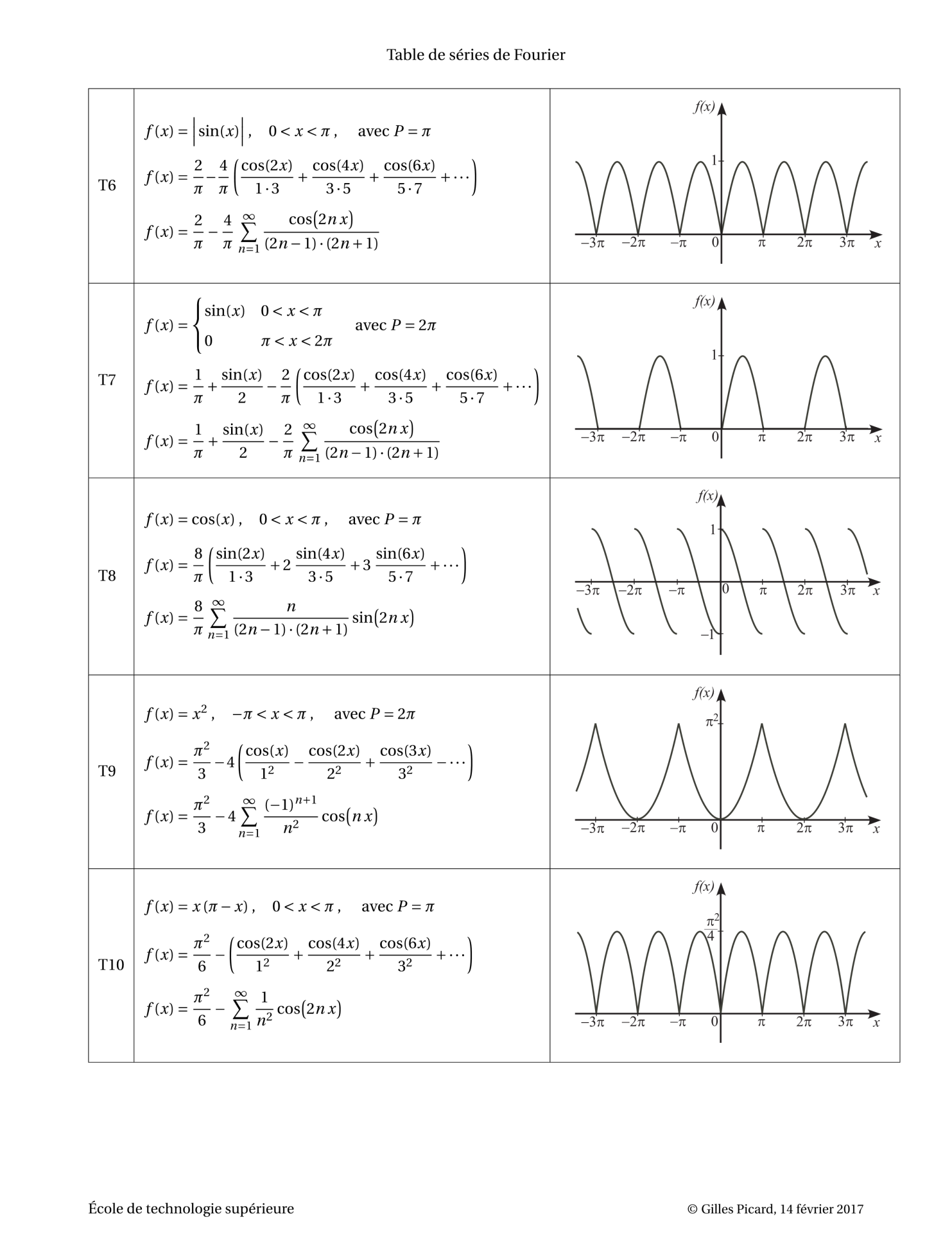푸리에 급수 테이블 , 푸리에 변환 테이블, Fourier Series Table, Fourier Transform Table
출처 : https://ena.etsmtl.ca/pluginfile.php/137982/mod_resource/content/8/Fourier-table.pdf


출처 : https://en.wikipedia.org/wiki/Fourier_transform
Functional relationships, one-dimensional
The Fourier transforms in this table may be found in [Erdélyi 1954] or [Kammler 2000, appendix].
| Function | Fourier transform unitary, ordinary frequency |
Fourier transform unitary, angular frequency |
Fourier transform non-unitary, angular frequency |
Remarks | |
|---|---|---|---|---|---|
| \[f(x)\] | \[\begin{align} &\widehat{f}(\xi) \triangleq \widehat {f_1}(\xi) \\&= \int_{-\infty}^\infty f(x) e^{-i 2\pi \xi x}\, dx \end{align}\] | \[\begin{align} &\widehat{f}(\omega) \triangleq \widehat {f_2}(\omega) \\&= \frac{1}{\sqrt{2 \pi}} \int_{-\infty}^\infty f(x) e^{-i \omega x}\, dx \end{align}\] | \[\begin{align} &\widehat{f}(\omega) \triangleq \widehat {f_3}(\omega) \\&= \int_{-\infty}^\infty f(x) e^{-i \omega x}\, dx \end{align}\] | Definitions | |
| 101 | \[a\, f(x) + b\, g(x)\] | \[a\, \widehat{f}(\xi) + b\, \widehat{g}(\xi)\] | \[a\, \widehat{f}(\omega) + b\, \widehat{g}(\omega)\] | \[a\, \widehat{f}(\omega) + b\, \widehat{g}(\omega)\] | Linearity |
| 102 | \[f(x - a)\] | \[e^{-i 2\pi \xi a} \widehat{f}(\xi)\] | \[e^{- i a \omega} \widehat{f}(\omega)\] | \[e^{- i a \omega} \widehat{f}(\omega)\] | Shift in time domain |
| 103 | \[f(x)e^{iax}\] | \[\widehat{f} \left(\xi - \frac{a}{2\pi}\right)\] | \[\widehat{f}(\omega - a)\] | \[\widehat{f}(\omega - a)\] | Shift in frequency domain, dual of 102 |
| 104 | \[f(a x)\] | \[\frac{1}{|a|} \widehat{f}\left( \frac{\xi}{a} \right)\] | \[\frac{1}{|a|} \widehat{f}\left( \frac{\omega}{a} \right)\] | \[\frac{1}{|a|} \widehat{f}\left( \frac{\omega}{a} \right)\] | Scaling in the time domain. If \[{{abs|a}}\] is large, then \[f(ax)\] is concentrated around 0 and \[\frac{1}{|a|}\hat{f} \left( \frac{\omega}{a} \right)\] spreads out and flattens. |
| 105 | \[\widehat {f_n}(x)\] | \[\widehat {f_1}(x) \ \stackrel{\mathcal{F}_1}{\longleftrightarrow}\ f(-\xi)\] | \[\widehat {f_2}(x) \ \stackrel{\mathcal{F}_2}{\longleftrightarrow}\ f(-\omega)\] | \[\widehat {f_3}(x) \ \stackrel{\mathcal{F}_3}{\longleftrightarrow}\ 2\pi f(-\omega)\] | The same transform is applied twice, but x replaces the frequency variable (ξ or ω) after the first transform. |
| 106 | \[\frac{d^n f(x)}{dx^n}\] | \[(i 2\pi \xi)^n \widehat{f}(\xi)\] | \[(i\omega)^n \widehat{f}(\omega)\] | \[(i\omega)^n \widehat{f}(\omega)\] | nth-order derivative. As \[f\] is a [[Schwartz space|Schwartz function]] |
| 106.5 | \[\int_{-\infty}^{x} f(\tau) d \tau\] | \[\frac{\widehat{f}(\xi)}{i 2 \pi \xi} + C \, \delta(\xi)\] | \[\frac{\widehat{f} (\omega)}{i\omega} + \sqrt{2 \pi} C \delta(\omega)\] | \[\frac{\widehat{f} (\omega)}{i\omega} + 2 \pi C \delta(\omega)\] | Integration.[1] Note: \[\delta\] is the [[Dirac delta function]] and \[C\] is the average ([[DC component|DC]]) value of \[f(x)\] such that \[\int_{-\infty}^\infty (f(x) - C) \, dx = 0\] |
| 107 | \[x^n f(x)\] | \[\left (\frac{i}{2\pi}\right)^n \frac{d^n \widehat{f}(\xi)}{d\xi^n}\] | \[i^n \frac{d^n \widehat{f}(\omega)}{d\omega^n}\] | \[i^n \frac{d^n \widehat{f}(\omega)}{d\omega^n}\] | This is the dual of 106 |
| 108 | \[(f * g)(x)\] | \[\widehat{f}(\xi) \widehat{g}(\xi)\] | \[\sqrt{2\pi}\ \widehat{f}(\omega) \widehat{g}(\omega)\] | \[\widehat{f}(\omega) \widehat{g}(\omega)\] | The notation \[f * g\] denotes the [[convolution]] of \[f\] and \[g\] — this rule is the [[convolution theorem]] |
| 109 | \[f(x) g(x)\] | \[\left(\widehat{f} * \widehat{g}\right)(\xi)\] | \[ \frac{1}{\sqrt{2\pi}} \left(\widehat{f} * \widehat{g}\right)(\omega) \] | \[\frac{1}{2\pi}\left(\widehat{f} * \widehat{g}\right)(\omega)\] | This is the dual of 108 |
| 110 | For \[f(x)\] purely real | \[\widehat{f}(-\xi) = \overline{\widehat{f}(\xi)}\] | \[\widehat{f}(-\omega) = \overline{\widehat{f}(\omega)}\] | \[\widehat{f}(-\omega) = \overline{\widehat{f}(\omega)}\] | Hermitian symmetry. \[\overline{z}\] indicates the [[complex conjugate]]. |
| 113 | For \[f(x)\] purely imaginary | \[\widehat{f}(-\xi) = -\overline{\widehat{f}(\xi)}\] | \[\widehat{f}(-\omega) = -\overline{\widehat{f}(\omega)}\] | \[\widehat{f}(-\omega) = -\overline{\widehat{f}(\omega)}\] | \[\overline{z}\] indicates the [[complex conjugate]]. |
| 114 | \[\overline{f(x)}\] | \[\overline{\widehat{f}(-\xi)}\] | \[\overline{\widehat{f}(-\omega)}\] | \[\overline{\widehat{f}(-\omega)}\] | [[Complex conjugation]], generalization of 110 and 113 |
| 115 | \[f(x) \cos (a x)\] | \[\frac{\widehat{f}\left(\xi - \frac{a}{2\pi}\right)+\widehat{f}\left(\xi+\frac{a}{2\pi}\right)}{2}\] | \[\frac{\widehat{f}(\omega-a)+\widehat{f}(\omega+a)}{2}\] | \[\frac{\widehat{f}(\omega-a)+\widehat{f}(\omega+a)}{2}\] | This follows from rules 101 and 103 using [[Euler's formula]]: \[\cos(a x) = \frac{e^{i a x} + e^{-i a x}}{2}.\] |
| 116 | \[f(x)\sin( ax)\] | \[\frac{\widehat{f}\left(\xi-\frac{a}{2\pi}\right)-\widehat{f}\left(\xi+\frac{a}{2\pi}\right)}{2i}\] | \[\frac{\widehat{f}(\omega-a)-\widehat{f}(\omega+a)}{2i}\] | \[\frac{\widehat{f}(\omega-a)-\widehat{f}(\omega+a)}{2i}\] | This follows from 101 and 103 using [[Euler's formula]]: \[\sin(a x) = \frac{e^{i a x} - e^{-i a x}}{2i}.\] |
[1] The Integration Property of the Fourier Transform
| Function | Fourier transform unitary, ordinary frequency |
Fourier transform unitary, angular frequency |
Fourier transform non-unitary, angular frequency |
Remarks | |
|---|---|---|---|---|---|
| \[ f(x) \] | \[ \begin{align} &\hat{f}(\xi) \triangleq \hat f_1(\xi) \\&= \int_{-\infty}^\infty f(x) e^{-i 2\pi \xi x}\, dx \end{align} \] | \[ \begin{align} &\hat{f}(\omega) \triangleq \hat f_2(\omega) \\&= \frac{1}{\sqrt{2 \pi}} \int_{-\infty}^\infty f(x) e^{-i \omega x}\, dx \end{align} \] | \[ \begin{align} &\hat{f}(\omega) \triangleq \hat f_3(\omega) \\&= \int_{-\infty}^\infty f(x) e^{-i \omega x}\, dx \end{align} \] | Definitions | |
| 301 | \[ 1 \] | \[ \delta(\xi) \] | \[ \sqrt{2\pi}\, \delta(\omega) \] | \[ 2\pi\delta(\omega) \] | The distribution \[ ''δ''(''ξ'') \] denotes the [[Dirac delta function]]. |
| 302 | \[ \delta(x) \] | \[ 1 \] | \[ \frac{1}{\sqrt{2\pi}} \] | \[ 1 \] | Dual of rule 301. |
| 303 | \[ e^{i a x} \] | \[ \delta\left(\xi - \frac{a}{2\pi}\right) \] | \[ \sqrt{2 \pi}\, \delta(\omega - a) \] | \[ 2 \pi\delta(\omega - a) \] | This follows from 103 and 301. |
| 304 | \[ \cos (a x) \] | \[ \frac{\delta\left(\xi - \frac{a}{2\pi}\right)+\delta\left(\xi+\frac{a}{2\pi}\right)}{2} \] | \[ \sqrt{2 \pi}\,\frac{\delta(\omega-a)+\delta(\omega+a)}{2} \] | \[ \pi\left(\delta(\omega-a)+\delta(\omega+a)\right) \] | This follows from rules 101 and 303 using [[Euler's formula]]: \[ \cos(a x) = \frac{e^{i a x} + e^{-i a x}}{2}. \] |
| 305 | \[ \sin( ax) \] | \[ \frac{\delta\left(\xi-\frac{a}{2\pi}\right)-\delta\left(\xi+\frac{a}{2\pi}\right)}{2i} \] | \[ \sqrt{2 \pi}\,\frac{\delta(\omega-a)-\delta(\omega+a)}{2i} \] | \[ -i\pi\bigl(\delta(\omega-a)-\delta(\omega+a)\bigr) \] | This follows from 101 and 303 using \[ \sin(a x) = \frac{e^{i a x} - e^{-i a x}}{2i}. \] |
| 306 | \[ \cos \left( a x^2 \right) \] | \[ \sqrt{\frac{\pi}{a}} \cos \left( \frac{\pi^2 \xi^2}{a} - \frac{\pi}{4} \right) \] | \[ \frac{1}{\sqrt{2 a}} \cos \left( \frac{\omega^2}{4 a} - \frac{\pi}{4} \right) \] | \[ \sqrt{\frac{\pi}{a}} \cos \left( \frac{\omega^2}{4a} - \frac{\pi}{4} \right) \] | This follows from 101 and 207 using \[ \cos(a x^2) = \frac{e^{i a x^2} + e^{-i a x^2}}{2}. \] |
| 307 | \[ \sin \left( a x^2 \right) \] | \[ - \sqrt{\frac{\pi}{a}} \sin \left( \frac{\pi^2 \xi^2}{a} - \frac{\pi}{4} \right) \] | \[ \frac{-1}{\sqrt{2 a}} \sin \left( \frac{\omega^2}{4 a} - \frac{\pi}{4} \right) \] | \[ -\sqrt{\frac{\pi}{a}}\sin \left( \frac{\omega^2}{4a} - \frac{\pi}{4} \right) \] | This follows from 101 and 207 using \[ \sin(a x^2) = \frac{e^{i a x^2} - e^{-i a x^2}}{2i}. \] |
| 308 | \[ e^{-\pi i\alpha x^2} \] | \[ \frac{1}{\sqrt{\alpha}}\, e^{-i\frac{\pi}{4}} e^{i\frac{\pi \xi^2}{\alpha}} \] | \[ \frac{1}{\sqrt{2\pi \alpha}}\, e^{-i\frac{\pi}{4}} e^{i\frac{\omega^2}{4\pi \alpha}} \] | \[ \frac{1}{\sqrt{\alpha}}\, e^{-i\frac{\pi}{4}} e^{i\frac{\omega^2}{4\pi \alpha}} \] | Here it is assumed \[ \alpha \] is real. For the case that alpha is complex see table entry 206 above. |
| 309 | \[ x^n \] | \[ \left(\frac{i}{2\pi}\right)^n \delta^{(n)} (\xi) \] | \[ i^n \sqrt{2\pi} \delta^{(n)} (\omega) \] | \[ 2\pi i^n\delta^{(n)} (\omega) \] | Here, \[ n \] is a [[natural number]] and \[ ''δ''{{isup|(''n'')}}\left(\xi\right) \] is the \[ n \]th distribution derivative of the Dirac delta function. This rule follows from rules 107 and 301. Combining this rule with 101, we can transform all [[polynomial]]s. |
| 310 | \[ \delta^{(n)}(x) \] | \[ (i 2\pi \xi)^n \] | \[ \frac{(i\omega)^n}{\sqrt{2\pi}} \] | \[ (i\omega)^n \] | Dual of rule 309. \[ ''δ''{{isup|(''n'')}}\left(\xi\right) \] is the \[ n \]th distribution derivative of the Dirac delta function. This rule follows from 106 and 302. |
| 311 | \[ \frac{1}{x} \] | \[ -i\pi\sgn(\xi) \] | \[ -i\sqrt{\frac{\pi}{2}}\sgn(\omega) \] | \[ -i\pi\sgn(\omega) \] | Here \[ sgn(\xi) \] is the [[sign function]]. Note that \[ \frac{1}{x} \] is not a distribution. It is necessary to use the [[Cauchy principal value]] when testing against [[Schwartz functions]]. This rule is useful in studying the [[Hilbert transform]]. |
| 312 | \[ \begin{align} &\frac{1}{x^n} \\ &:= \frac{(-1)^{n-1}}{(n-1)!}\frac{d^n}{dx^n}\log |x| \end{align} \] | \[ -i\pi \frac{(-i 2\pi \xi)^{n-1}}{(n-1)!} \sgn(\xi) \] | \[ -i\sqrt{\frac{\pi}{2}}\, \frac{(-i\omega)^{n-1}}{(n-1)!}\sgn(\omega) \] | \[ -i\pi \frac{(-i\omega)^{n-1}}{(n-1)!}\sgn(\omega) \] | \[ \frac{1}{x^n} \] is the [[homogeneous distribution]] defined by the distributional derivative \[ \frac{(-1)^{n-1}}{(n-1)!}\frac{d^n}{dx^n}\log|x| \] |
| 313 | \[ |x|^\alpha \] | \[ -\frac{2\sin\left(\frac{\pi\alpha}{2}\right)\Gamma(\alpha+1)}{|2\pi\xi|^{\alpha+1}} \] | \[ \frac{-2}{\sqrt{2\pi}}\, \frac{\sin\left(\frac{\pi\alpha}{2}\right)\Gamma(\alpha+1)}{|\omega|^{\alpha+1}} \] | \[ -\frac{2\sin\left(\frac{\pi\alpha}{2}\right)\Gamma(\alpha+1)}{|\omega|^{\alpha+1}} \] | This formula is valid for \[ 0 > \alpha > -1 \]. For \[ \alpha > 0 \] some singular terms arise at the origin that can be found by differentiating 320. If \[ Re \alpha > -1 \], then \[ |x|^\alpha \] is a locally integrable function, and so a tempered distribution. The function \[ \alpha \mapsto |x|^\alpha \] is a holomorphic function from the right half-plane to the space of tempered distributions. It admits a unique meromorphic extension to a tempered distribution, also denoted \[ |x|^\alpha \] for \[ \alpha \neq -1, -3, ... \] (See [[homogeneous distribution]].) |
| \[ \frac{1}{\sqrt{|x|}} \] | \[ \frac{1}{\sqrt{|\xi|}} \] | \[ \frac{1}{\sqrt{|\omega|}} \] | \[ \frac{\sqrt{2\pi}}{\sqrt{|\omega|}} \] | Special case of 313. | |
| 314 | \[ \sgn(x) \] | \[ \frac{1}{i\pi \xi} \] | \[ \sqrt{\frac{2}{\pi}} \frac{1}{i\omega} \] | \[ \frac{2}{i\omega} \] | The dual of rule 311. This time the Fourier transforms need to be considered as a [[Cauchy principal value]]. |
| 315 | \[ u(x) \] | \[ \frac{1}{2}\left(\frac{1}{i \pi \xi} + \delta(\xi)\right) \] | \[ \sqrt{\frac{\pi}{2}} \left( \frac{1}{i \pi \omega} + \delta(\omega)\right) \] | \[ \pi\left( \frac{1}{i \pi \omega} + \delta(\omega)\right) \] | The function \[ u(x) \] is the Heaviside [[Heaviside step function|unit step function]]; this follows from rules 101, 301, and 314. |
| 316 | \[ \sum_{n=-\infty}^{\infty} \delta (x - n T) \] | \[ \frac{1}{T} \sum_{k=-\infty}^{\infty} \delta \left( \xi -\frac{k }{T}\right) \] | \[ \frac{\sqrt{2\pi }}{T}\sum_{k=-\infty}^{\infty} \delta \left( \omega -\frac{2\pi k}{T}\right) \] | \[ \frac{2\pi}{T}\sum_{k=-\infty}^{\infty} \delta \left( \omega -\frac{2\pi k}{T}\right) \] | This function is known as the [[Dirac comb]] function. This result can be derived from 302 and 102, together with the fact that \[ \begin{align} & \sum_{n=-\infty}^{\infty} e^{inx} \\ = {}& 2\pi\sum_{k=-\infty}^{\infty} \delta(x+2\pi k) \end{align} \] as distributions. |
| 317 | \[ J_0 (x) \] | \[ \frac{2\, \operatorname{rect}(\pi\xi)}{\sqrt{1 - 4 \pi^2 \xi^2}} \] | \[ \sqrt{\frac{2}{\pi}} \, \frac{\operatorname{rect}\left(\frac{\omega}{2}\right)}{\sqrt{1 - \omega^2}} \] | \[ \frac{2\,\operatorname{rect}\left(\frac{\omega}{2}\right)}{\sqrt{1 - \omega^2}} \] | The function \[ J_0(x) \] is the zeroth order [[Bessel function]] of first kind. |


세상의모든계산기 님의 최근 댓글
교점이 2개 이상일때 모든 값을 구하는 법 계산기마다 가능/불가능이 갈릴 수도 있고, 수식에 따라 가능/불가능이 갈릴 수도 있죠. 불확실할때는 그래프로 확인하세요. 2025 12.16 T가 410인 해를 찾는 방법 -> 초기값을 입력하세요. [공학용 계산기] 공학용 계산기의 꽃? solve (솔브) 기능 이해하기 (Newton-Raphson 법, 뉴튼법) https://allcalc.org/11532 2025 12.16 참고 - [공학용 계산기] 정적분 계산 속도 벤치마크 비교 https://allcalc.org/9677 2025 12.11 다른 계산기의 경우와 비교 1. TI-nspire CAS ㄴ CAS 계산기는 가능한 경우 부정적분을 먼저하고, 그 값에 구간을 대입해 최종값을 얻습니다. ㄴ 부정적분이 불가능할 때는 수치해석적 방법을 시도합니다. 2. CASIO fx-991 ES Plus ㄴ CASIO 계산기의 경우, 적분할 함수에 따라 시간이 달라지는 것으로 알고 있는데, 정밀도를 확보할 별도의 알고리즘을 채택하고 있는 것이 아닐까 생각되네요. 2025 12.11 일반 계산기는 보통 리셋기능이 따로 없기 때문에, 다른 요인에 영향을 받을 가능성은 없어 보이구요. '원래는 잘 되었는데, 지금은 설정 값이 날아간다'면 메모리 값을 유지할만큼 배터리가 꾸준하게 공급되지 않기 때문일 가능성이 높다고 봐야겠습니다. - 태양광이 있을 때는 계산은 가능하지만, 서랍등에 넣으면 배터리가 없어서 리셋 https://blog.naver.com/potatoyamyam/223053309120 (교체 사진 참조) 1. 배터리 준비: * 다이소 등에서 LR54 (LR1130) 배터리를 구매합니다. (보통 4개 들이 1,000원에 판매됩니다. LR44와 높이가 다르니 혼동하시면 안됩니다.) 2. 준비물: * 작은 십자드라이버 (계산기 뒷면 나사용. 이것도 없으시면 다이소에서...) 3. 커버 분해: * 계산기 뒷면의 나사를 풀고, 머리 부분(윗부분)의 커버를 조심스럽게 분해합니다. (참고해주신 블로그 사진을 보시면 이해가 빠르실 겁니다.) 4. 배터리 교체: * 기존 배터리를 빼냅니다. * 새 LR54 배터리의 '+'극 방향을 정확히 확인하여 제자리에 넣어줍니다. (대부분의 경우 '+'극이 위로 보이도록 넣습니다.) 5. 조립: * 커버를 다시 닫고 나사를 조여줍니다. * 블로그 사진을 보니 배터리 연결선 등이 눌려서 씹혀 있네요. 원래 씹히도록 설계를 안하는데, 원래 그렇게 만들어 놓은 건지? 모르겠네요. 여튼 씹히면 단선될 가능성이 있으니, 잘 보시고 플라스틱 틈새 등으로 적절히 배치해서 안씹히게 하는 것이 좋습니다. 6. TAX 재설정: * 계산기의 전원을 켜고 TAX 요율을 10%로 다시 설정합니다. 2025 12.10